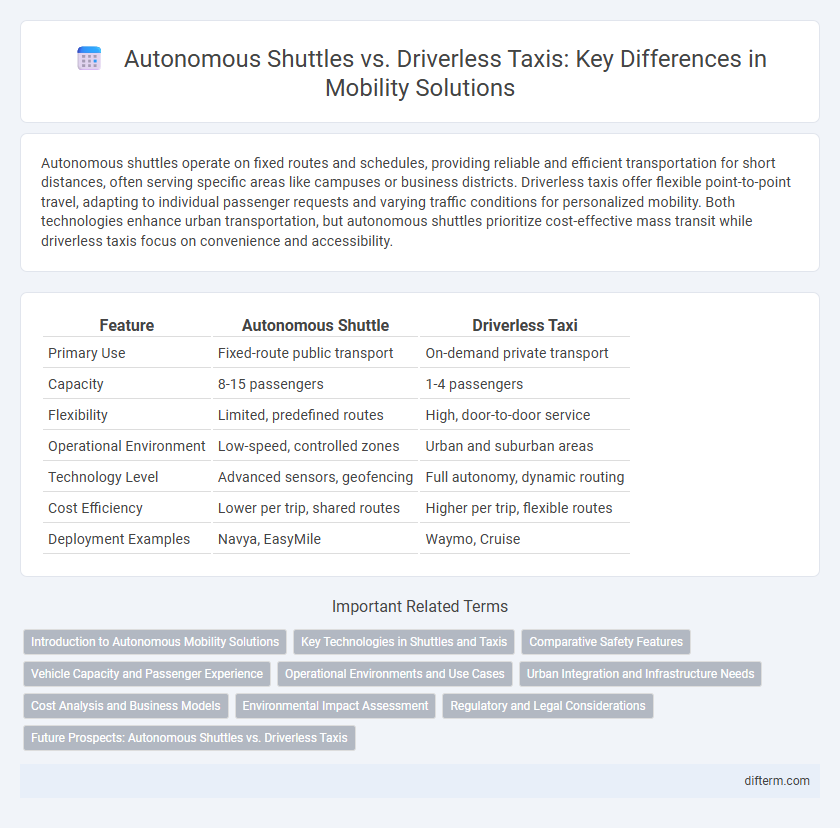Autonomous shuttles operate on fixed routes and schedules, providing reliable and efficient transportation for short distances, often serving specific areas like campuses or business districts. Driverless taxis offer flexible point-to-point travel, adapting to individual passenger requests and varying traffic conditions for personalized mobility. Both technologies enhance urban transportation, but autonomous shuttles prioritize cost-effective mass transit while driverless taxis focus on convenience and accessibility.
Table of Comparison
| Feature | Autonomous Shuttle | Driverless Taxi |
|---|---|---|
| Primary Use | Fixed-route public transport | On-demand private transport |
| Capacity | 8-15 passengers | 1-4 passengers |
| Flexibility | Limited, predefined routes | High, door-to-door service |
| Operational Environment | Low-speed, controlled zones | Urban and suburban areas |
| Technology Level | Advanced sensors, geofencing | Full autonomy, dynamic routing |
| Cost Efficiency | Lower per trip, shared routes | Higher per trip, flexible routes |
| Deployment Examples | Navya, EasyMile | Waymo, Cruise |
Introduction to Autonomous Mobility Solutions
Autonomous shuttles operate on fixed routes within defined areas such as campuses or urban centers, providing efficient and predictable transport for multiple passengers. Driverless taxis use advanced AI and sensor fusion to navigate dynamically in complex urban environments, offering personalized point-to-point travel. Both solutions leverage cutting-edge autonomous vehicle technologies to enhance urban mobility, reduce traffic congestion, and improve transportation accessibility.
Key Technologies in Shuttles and Taxis
Autonomous shuttles rely on LiDAR sensors, GPS, and advanced machine learning algorithms to navigate fixed routes with high precision and safety. Driverless taxis employ similar technologies but incorporate dynamic route planning, real-time traffic data integration, and sophisticated passenger interaction systems to handle diverse urban environments. Both systems leverage V2X communication and computer vision to enhance situational awareness and facilitate seamless mobility solutions.
Comparative Safety Features
Autonomous shuttles incorporate advanced sensor arrays and geofencing to operate at lower speeds within predefined routes, minimizing collision risks in controlled environments. Driverless taxis utilize sophisticated AI algorithms and real-time traffic data for dynamic route adjustments, enhancing responsiveness to unpredictable urban conditions. Both prioritize pedestrian detection and emergency braking systems, but shuttles often benefit from simplified safety protocols due to restricted operating zones.
Vehicle Capacity and Passenger Experience
Autonomous shuttles typically offer larger vehicle capacities, accommodating 8 to 20 passengers, which makes them ideal for group travel and public transit routes. Driverless taxis, designed for individual or small group rides, usually seat 1 to 4 passengers, providing more personalized and flexible transportation. The passenger experience in autonomous shuttles emphasizes communal travel and fixed routes, while driverless taxis prioritize privacy, door-to-door service, and dynamic routing.
Operational Environments and Use Cases
Autonomous shuttles are typically deployed in controlled environments such as campuses, business parks, and closed-loop transit zones, enabling predictable routes and lower speeds ideal for short-distance passenger transport. Driverless taxis operate in complex urban settings, navigating dynamic traffic conditions and varying road types to provide flexible, on-demand point-to-point services. The operational environment dictates use cases, with shuttles focusing on last-mile connectivity and driverless taxis targeting broader urban mobility and ride-hailing applications.
Urban Integration and Infrastructure Needs
Autonomous shuttles require dedicated routes and simplified urban infrastructure to operate efficiently, often benefiting from predefined paths in controlled environments such as campuses or business districts. Driverless taxis demand more complex integration with existing urban traffic systems, relying on advanced sensor networks, dynamic ride-hailing platforms, and flexible routing capabilities to navigate diverse city streets. Infrastructure needs for autonomous shuttles emphasize dedicated lanes and charging stations, while driverless taxis depend heavily on robust data communication networks and scalable urban mobility management systems.
Cost Analysis and Business Models
Autonomous shuttles typically present lower operational costs due to fixed routes and shared rides, making them suitable for public transit and corporate campus services with predictable demand. Driverless taxis incur higher expenses from complex routing algorithms and individual ride demand but benefit from flexible, on-demand service models catering to urban environments. Business models for autonomous shuttles often rely on subsidies or partnerships with municipalities, whereas driverless taxis pursue revenue through dynamic pricing and direct consumer engagement.
Environmental Impact Assessment
Autonomous shuttles typically operate on fixed routes with higher passenger capacity, resulting in lower per-passenger emissions compared to driverless taxis, which often function as on-demand services with variable occupancy. Lifecycle environmental impact assessments reveal shuttles generally consume less energy and produce fewer greenhouse gases due to optimized routing and shared usage patterns. Emphasizing electric propulsion and route efficiency, autonomous shuttles can significantly reduce urban air pollution and carbon footprints in comparison to driverless taxis.
Regulatory and Legal Considerations
Autonomous shuttles typically operate on fixed routes and predefined areas, simplifying regulatory approval due to controlled environments and limited interaction with unpredictable traffic scenarios. Driverless taxis require comprehensive regulatory frameworks addressing mixed traffic operation, passenger safety, and liability in diverse urban settings. Legal considerations for both include data privacy, cybersecurity standards, and insurance liability models adapting to emerging autonomous technologies.
Future Prospects: Autonomous Shuttles vs. Driverless Taxis
Autonomous shuttles are projected to excel in fixed-route, high-demand corridors, offering efficient last-mile connectivity with lower operational costs due to shared rides and predictable routes. Driverless taxis promise greater flexibility and convenience through on-demand, door-to-door service, leveraging advanced AI for dynamic routing and personalized travel experiences. Integration of both systems is anticipated to revolutionize urban mobility by balancing scalable public transit options with individualized, efficient point-to-point transportation.
Autonomous shuttle vs driverless taxi Infographic

 difterm.com
difterm.com